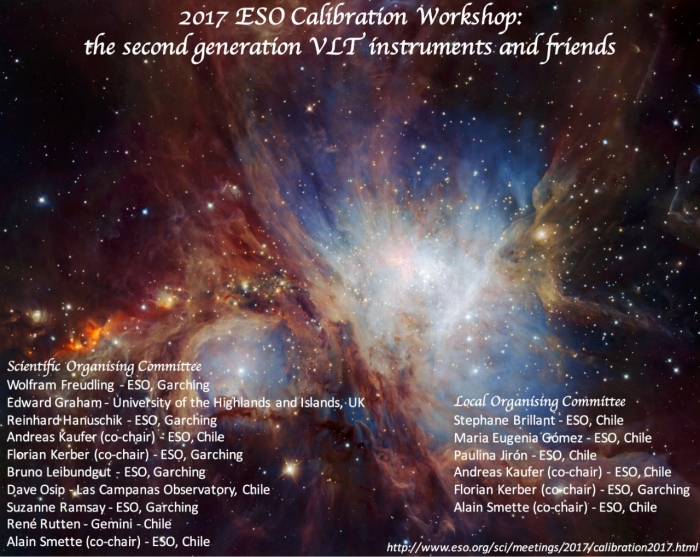2017 ESO Calibration Workshop: the second generation VLT instruments and friends
Santiago, Chile, January 16-19, 2017
Scientific Rationale
Calibration is a critical component in the conversion of raw data to material ready for scientific analysis. Consequently a complete, consistent calibration plan for each data set fulfilling quality control criteria was recognized as a cornerstone of VLT operation. In 2007, ESO organized its first calibration workshop to (a) foster the sharing of information, experience and techniques between observers, instrument developers and instrument operation teams, (b) review the actual precision and limitations of the applied instrument calibration plans, and (c) collect the current and future requirements by the ESO users. It focused on calibration issues affecting the first generation instruments.
Ten years later, ESO instrumentation has changed considerably following the arrival of second generation instruments or the completion of major upgrades of first generation ones - HARPS, KMOS, MUSE, SPHERE, VISIR, X-shooter. In the near future, it will evolve further with the completion of the upgrade of CRIRES, the arrival of ESPRESSO and the AOF-assisted instruments MUSE and HAWK-I, as well as the proposed SOXS and NIRPS, ERIS, MOONS, and 4MOST. For many of them, the increase in complexity requires challenging calibration for optimum performance.
With the 2017 ESO Calibration Workshop we intend to bring together astronomers and instrument scientists from various fields of expertise to share their experience, engage in open discussion, challenge current limitations and try to develop creative concepts for better calibration in the future. We plan to cover
- all calibration aspects that are relevant to the user community or science operations for ESO’s Paranal (VLT) and La Silla sites,
- the progress made in characterizing the properties of the atmosphere that allow science operations to make the best use of the current conditions,
- the progress made in data reduction and pipeline tools.
Potential topics therefore include high quality flat-fielding; high precision wavelength calibration; metrology; calibration for high contrast imaging, astrometry, integral field spectroscopy, multiple object spectroscopy (multi-slit, multi-fiber), photometry; infra-red sky background correction; reference data (atomic and molecular line parameters); characterization of atmospheric properties and forecasting; atmospheric modeling for data reduction, calibration challenges of survey instruments.
On the other hand, the workshop will not cover calibration issues specific to E-ELT instruments, ALMA, APEX, and VLTI as their specific needs are better served by separate meetings.
We extend a special invitation to our colleagues from other ground-based observatories to foster collaboration between organisations and to learn from each other. The venue of the conference has been chosen with a view to the high concentration of major observatories in Chile covering a wide range of facilities.
As a first we have decided to pre-allocate time at the VLT in preparation of the calibration workshop. This time will be used to execute novel and innovative self-contained calibration methods and concepts. We plan to collect such proposals in advance, discuss their content and merit with all participants at the workshop and select the most convincing projects in a competitive peer-reviewed process. These will then be executed during the pre-allocated time in due course. Don’t miss this unique opportunity to present your exciting ideas to a group of experts and have them tested in real-life as a fast track project.
Conference email: calibration2017@eso.org
Organizer: ESO
Second Announcement
Quick links
- Home
- SOC/LOC
- Invited Speakers
- Deadlines
- Registration
- Registration Fee Payment
- Programme
- Information for Speakers
- Information for Posters
- Information about Zenodo
- Template for calibration proposals (LaTeX file)
- Participants
- Travel Information
- Accommodation
- Local Information

